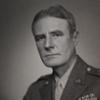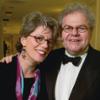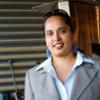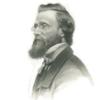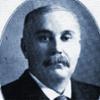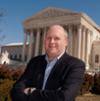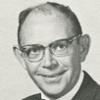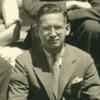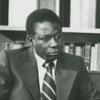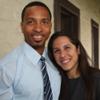Seldom-Told Tales
So, as befits a College where writing and speaking have mattered so deeply for so long, we instead collected a few good stories — alumni accomplishments, asides, anecdotes, tall tales and fascinating footnotes of all kinds drawn from many generations. You’ll learn about a preacher who took on “the wickedest town in the West.” You’ll meet a lawyer who frees wrongly convicted men, and another who turns election losses into victories. You’ll catch up with an alumnus who led Alex Haley to his roots. And you’ll find out why a California mountain is named after a Hamiltonian named, of all things, Hamilton.
We present them here as a random sampling of profiles in words and images, the first strokes of a community portrait to which the Alumni Review, with your help, will continue to add. This feature will grow online with a gradually expanding gallery of profiles; send your contributions or suggestions to editor@hamilton.edu.
Life as a conference call while standing in a river
Most people spend years searching for their dream job; Andrew Lee ’94 jokes that he walked away from his. It was 2005, and Lee was, at age 32, executive director of the Harvard Project on American Indian Economic Development and the founder of Honoring Nations, an associated program that documents outstanding tribal governance. But, he says, “I’ve always been comfortable in what others might describe as ‘walking in multiple worlds.’”
His new world was Aetna, Inc., the health benefits company where Lee is now vice president and head of hospitalist solutions. But a career in the private sector with a Fortune 100 firm has only encouraged his desire to stay involved and to “build bridges between communities, cultures and sectors.” His continued work on a variety of boards and his contributions to The State of the Native Nations — a magisterial 2008 volume on social and economic conditions among American Indian tribes as they work toward self-determination — led to his selection late last year as a Young Global Leader by the World Economic Forum.
It was not simply an honorific; the more than 600 Young Global Leaders from more than 100 countries meet regularly to tackle everything from climate change to public health to international economics. Among Lee’s colleagues are Google co-founders Larry Page and Sergey Brin, Facebook mastermind Mark Zuckerberg, author Dave Eggers and Courtney O’Donnell, former director of communications in the Office of the Vice President. “There’s something really powerful about pulling together social entrepreneurs, business leaders, thought leaders, government officials and others to discuss and take action on compelling challenges,” he says.
As the first American Indian to be selected for the group, Lee is again walking in multiple worlds, and he points out that it’s a natural role for him. “I was raised in a Connecticut suburb and attended public schools, but also made frequent visits to our reservation in western New York to see relatives and participate in Seneca cultural activities,” he says. “I’ve been fortunate to get a world-class education at Hamilton and Harvard, but I’ve also had many opportunities to learn from grassroots tribal leaders whose struggles and triumphs are nothing short of amazing.”
His adaptability extends to his life beyond work; he makes it a point to balance professional commitments with his love of bowhunting and fly fishing. “I’ve been known on occasion,” he says, “to send emails from a tree stand in the woods or take a conference call while standing in the middle of a river.”
— Donald Challenger
Hamilton’s most decorated veteran helped turn WWI
Spring 2012In the late spring of 1918, as Germany pushed to end World War I decisively before the American Expeditionary Force could come to the aid of its allies, the Germans unleashed a series of attacks on the Western Front. One took the Germans to Château-Thierry on the Marne River, just 40 miles from Paris. Among the overextended American forces in the region, the first to the rescue were 24-year-old 1st Lt. John T. Bissell and a small, sleep-deprived advance unit of the 7th Machine Gun Battalion (Motorized), 3rd Division.
Bissell and his unit, covering a French retreat as they also fought to slow the massive German assault on the town, were stranded under heavy fire when the only nearby bridge to safety was blown up, but managed to pull back to a safer position after finding another bridge in the dark. “It is believed,” a later military report found, “that the 7th Machine Gun Battalion was to a great degree responsible for the final check of the late German drive.” It was a critical tipping point, since within days the American 2nd and 3rd Divisions would arrive, shutting down the German offensive over the next few weeks — “effectively saving Paris,” according to The United States in the First World War: An Encyclopedia, “and quite likely the Allied cause.”
Bissell was awarded the French Croix de Guerre and the Silver Star for gallantry in action, but it was only an early chapter in a stellar military career. The 1917 West Point graduate would return to teach at the military academy as well as at Princeton — he taught French at the former and military science at the latter — and in 1940 he became executive officer of the Counter-Intelligence Group of the Military Intelligence Division, now the Military Intelligence Corps. In World War II Bissell served as brigadier general of the 112th Armored Field Artillery Group and was honored with the Legion of Merit and the Bronze Star for his actions in the Battle of the Bulge. He died in 1976 in Carmel, Calif. His medals are kept in the College Archives.
— Katie Hee ’14
Her ‘line of work’ is exploring music’s innate mystery
Spring 2012As a small child, Mindy Wagner thought music was a pre-existing entity; anyone could just snatch a song out of the ether like one plucks a peach off a tree. It wasn’t until she began attending children’s concerts at the Academy of Music in Philadelphia that she realized someone had to create music before it was played. Ironically, she was already doing just that; she had begun writing piano pieces when she was about 5. They were the first steps in a musical journey that would lead to the 1999 Pulitzer Prize in Music for her Concerto for Flute, Strings, and Percussion. As Professor of Comparative Literature Peter Rabinowitz noted in his presentation of an honorary degree to Wagner in 2001, “By the time you understood what a composer was, you had already become one.”
Wagner enrolled at Kirkland College and studied under Jay Reise ’72 before graduating with Hamilton’s first coeducational class and earning graduate degrees at the University of Chicago and the University of Pennsylvania. She has been “composing steadily” since becoming one of only four women to win the music Pulitzer, while also teaching and raising two children. All of her creative projects have been commissioned works — “In other words, I am rewarded with a paycheck!” — and her critical stature has continued to grow, based on such works as Extremity of Sky, a piano concerto commissioned by the Chicago Symphony for Emanuel Ax, and a trombone concerto for Joseph Alessi and the New York Philharmonic.
Her music has been praised for its “lithe sense of mystery,” its “prismatic color and romantic fantasy,” its “wonderful atmosphere,” its “kaleidoscopic textures” and Wagner’s talent for balancing finely crafted structure and moments of magic and flight.
Most important, perhaps, Wagner can be irreverent about her calling — she refers to composing as “my line of work” — while maintaining her childhood sense of wonder at the nature of music. It “profoundly affects us in ways we still do not understand,” she says. “It is completely abstract, and it is temporal. We cannot touch it, see it or walk around it — yet it can make us cry, or get up and dance.”
— Allison Eck ’12
She found ‘a place where people invented the future’
“Often, the robots in Japanese movies save the day,” Mary Bernardine Dias says. “In the USA, robots tend to be destroyers more often, like the Terminator robots.” The observation of an astute international film critic? No, the findings of an associate research professor at Carnegie Mellon’s Robotics Institute and founder-director of the TechBridgeWorld group, which develops culturally friendly technology for underserved communities around the globe.
Movies matter because Dias devotes her professional life to that realm where cultural attitudes and technology rub up against each other. Much of her work is focused on human-robotic teamwork — not just a top-down chain of command, but a nuanced interaction where strengths are balanced between human and nonhuman members. Dias — who arrived at Hamilton from Sri Lanka with a focus on physics, then discovered both computer science and women’s studies —found a way to meld those interests at the Robotics Institute. “I really felt like it was a place where people invented the future,” she says.
She was sure of her path early. “My parents tell me that I wanted to be a scientist from the age of 4,” she says, and she founded TechBridgeWorld in 2003, before she had even earned her Ph.D. But her interest in how robotics might be put to use took a new and urgent turn a year later, as she and members of her family vacationed in Sri Lanka. They left the coastal capital of Colombo, where they had been enjoying the beach, just hours before the catastrophic tsunami of Dec. 26, 2004, struck. Her uncle was among an estimated 40,000 people killed in Sri Lanka, one of the most devastated countries. It was “a difficult experience,” Dias says. But it “showed me that my work in [robotic team] coordination could have applications in disaster response, so it was the beginning of my research on that topic.”
Siblings Mary Beatrice Dias ’04 and Freddie Dias ’06 followed her to Hamilton and have since worked with her at Carnegie Mellon; Mary Beatrice recently completed a Ph.D. in engineering and public policy. “In robotics, we are an interesting mix of scientists and engineers, so we not only care about the hard science but also about the users of our innovations,” Mary Bernardine Dias says. “The goal is to create technology that is useful to people in a way that doesn’t force them to change their culture in ways they don’t want.”
— Donald Challenger
Portrait painter of presidents and stars
“It was only a freak of fun,” wrote Andrew Hull in recounting the story of his classmate’s spontaneous blackboard etchings. As he held a light to Daniel Huntington’s chalky creations, he admired them; the depiction of two students and a tutor, he said, was “in excellent style.” He also predicted widespread fame for the young Huntington: “There was genius in that sketch, and a promise to be fulfilled in later years.”
Huntington first became interested in art after meeting Charles Elliott, just four years older, who visited the Hill to paint the College’s second president, Henry Davis, and would become one of the most highly regarded portrait artists of the day. Later Huntington became a pupil of Henry Inman of Utica and Samuel F. B. Morse, who was then a professor of arts and design at New York University but found time to develop the telegraph and help invent Morse code on the side.
After graduating from Hamilton, Huntington spent several years honing his craft in the highlands of the Hudson and abroad in Italy. His early works won accolades at the Paris Exposition in 1867 and the Philadelphia Centennial in 1876. Upon trying his hand at portraits, he became one of the most feverishly sought-after artists in the nation, and his subjects ranged from Presidents Lincoln, Van Buren and Arthur to Cornelius Vanderbilt and William Cullen Bryant.
Huntington was a founder of the New York Century Club, president of the National Academy of Design, vice-president of the Metropolitan Museum of Art for 33 years, and rector of the department of art at Rutgers Female College in New York.
While his influence as a historical painter was expansive, Theodore L. Cuyler articulated the effect Huntington’s work had on him as an individual: “I owe him a debt of gratitude,” he wrote in an 1893 issue of The Evangelist, “because ‘Mercy’s Dream’ was the first thing that ever awakened a love of art in my own cranium.”
— Allison Eck ’12
He helped tame ‘the wickedest town in the West’
The namesake of Wright Memorial Presbyterian Church in Barnegat, N.J., where he served as pastor for more than three decades, Ormond Wright no doubt found his Jersey Shore ministry a more placid one than the mission he undertook as a young minister just four years removed from the Hill.
In 1877 the church board dispatched him to “the wickedest town in the West,” Dodge City, Kan. That “sewer of evil and degradation,” at the nexus of a cattle trail and a railroad, was booming toward a population of 1,000 and had already run several clerics out of town, according to the Barnegat church’s website (www.wrightchurch.org). But when the “small dignified man in a top hat and tail coat” arrived just in time to provide a compassionate funeral for a prostitute killed in a saloon brawl, Wright began to build a following among the gun-toting, hard-drinking citizenry. He soon reported a congregation of 13 members, and The Dodge City Times of June 8, 1878, announced its formation in this way:
The wicked city of Dodge can at last boast of a Christian organization, a Presbyterian Church. It was organized last Sunday a week. We would have mentioned the matter last week but we thought it best to break the news gently to the outside world.
The Presbyterian board soon provided him with $450 to build a church, and his small but growing congregation matched the gift. Legendary lawmen Wyatt Earp and Bat Masterson are believed to have been deacons in the church Wright established, and years later Masterson wrote a letter of tribute to one of Dodge City’s true peacekeepers. The letter, in the College’s archives, recalls Wright as “a genial, kind-hearted soul who had a faculty of making friends and keeping them.”
Wright, who in later years made regular tours of Barnegat in a wheelchair pushed by his daughter, died peacefully there in 1937 — 54 years removed from Dodge City, the one-time “citadel of Satan.”
— Donald Challenger
Postmaster general for just 290 days, he left his stamp
Among the many Hamiltonians to serve in top-tier federal posts, Thomas James is at first glance the most forgettable. Having turned down the position of postmaster general under two presidents, he finally accepted the post from President Garfield in March 1881 —then held it for barely nine months because his boss was assassinated.
The story runs deeper, however, and James’ impact on the mails and civil service was dramatic. Born in Utica, James worked as a printer and abolitionist journalist before earning his Hamilton degree at the advanced age of 32. Moving up through a series of customs positions in New York City, he built a reputation for efficiency, reorganizing a labyrinth of records and clearing out years of backlogged work in a few months. His no-nonsense approach caught the eye of Chester Arthur, the future president who was at that point collector for the Port of New York; Arthur asked James to join and then chair the board overseeing civil service appointments.
He then served as state postmaster of New York under Presidents Grant and Hayes, and by the 1870s had built a strong reputation as a pioneering advocate for a then-contentious idea: reforming the civil service sector so that jobs were awarded on the basis of testing and merit rather than through patronage. Coincidentally, his chief antagonist in this political struggle was fellow Utican Sen. Roscoe Conkling, who ran New York’s vast Republican patronage machine. (A third figure with ties to the Hamilton area played a much more bizarre role in James’ career arc. Charles Guiteau had been a member of the utopian Oneida Community, just a few miles west of the Hill where James was completing his degree, before eventually turning to politics and seeking an ambassadorship from Garfield. Rebuffed, he shot the president on July 2, 1881; Garfield died 79 days later, leading to James’ resignation.)
In his brief historical moment as postmaster general, though, James enacted a series of reforms and directed a draconian debt reduction; he also assisted the Department of Justice in uprooting the “Star Routes” fraud ring that was draining the Postal Service. In large part because of James’ cost-cutting, the postal rate was cut from 6 cents to 4 cents and then 2 cents for a one-ounce letter, the only such reductions in history other than wartime adjustments.
— Donald Challenger
In the biggest recount, he got the last laugh
Marc Elias is a self-described “huge Giants fan,” and on the morning after Super Bowl XLVI he is as ebullient in discussing New York’s win over the New England Patriots as he is restrained in dissecting another historic come-from-behind victory that he himself quarterbacked. That would be the 2008-09 recount marathon that ultimately gave comedian-turned-Democratic activist Al Franken a U.S. Senate seat from Minnesota.
As lead counsel for Franken, Elias — a partner and the chair in political law practice at Perkins Coie in Washington, D.C., as well as general counsel to the Democratic Senatorial Campaign Committee — was the key figure in a national political drama that stretched from election night until the following July, cost $60 million and involved a manual recount of nearly three million votes. It was the biggest, costliest and longest vote recount in U.S. history. In the end, the Minnesota Supreme Court agreed unanimously with Elias on the counting of contested absentee ballots, giving Franken a 315-vote victory over Republican incumbent Norm Coleman.
“We thought there were some young people, first-time voters whose ballots hadn’t been counted and should have been counted, and that if we pressed to get those ballots counted, they’d probably work out in our favor,” Elias says. But, he adds, “after the fact, it’s easy to give a lot of credit to me or the folks on the Franken side. But the truth is that it was a long, hard-fought battle. In the end, Al Franken got more votes. That’s ultimately the reason why he won.”
Elias believes that with the Minnesota battle and the 2000 “hanging chad” drama that decided the presidency in Florida, recounts are “becoming part of the system.” As a veteran of campaign wars — he was general counsel to the Kerry-Edwards campaign in 2004, has been involved in several recount fights and campaign finance cases, and was recently named to Politico.com’s “50 Politicos to Watch” list — he is well-positioned to see more high-profile action.
Oddly, though, his relationship with Franken came through a chance encounter. Nine months before the 2008 election, Elias was doing a campaign-law briefing for novice Senate candidates, and he was keeping it light. Franken was there. When it was over, the former Saturday Night Live star walked up to Elias and said, “You know, you’re a very funny guy.”
— Donald Challenger
‘A dedicated Dreamer in a land most strange’
Spring 2012Morteza Drexel Sprague grew up in Washington, D.C., where he graduated from Dunbar High School — then the top secondary school in the nation for blacks. At Hamilton, he was a member of the local fraternity, The Decagon, and graduated with an A.B. In 1930, Sprague earned an M.A. from Howard University and joined the faculty of Tuskegee Institute as head of the English Department. As a professor of English, Sprague — scarcely older than his students — taught two of the most important black American writers and intellectuals of the 20th century: Ralph Ellison and Albert Murray.
Ellison, author of the 1952 American classic Invisible Man, dedicated his first book of essays, Shadow and Act, to Sprague, calling him “A dedicated Dreamer in a land most strange.” Ellison biographer Lawrence Jackson, in Ralph Ellison: Emergence of a Genius, wrote that “Sprague … brought the aura of intellectual brilliance and independent thought to the campus” and was “extraordinarily popular among students.”
As “a Tuskegee freshman I took his senior course in the 19th century English novel,” Ellison said. “He was an honest teacher, for when I went to him about Eliot and such people, he told me … that they weren’t taught at Tuskegee. But he told me what to do about it: the places to find discussions and criticism.”
Murray, a renowned writer on literature, the blues and jazz, recalls that “the mere sight of him strolling across the campus … with a clutch of new books and new magazines in the crook of his left arm or against his lapel … was enough to evoke the whole world of Arts and Letters …. Morteza Drexel Sprague expected you to proceed in terms of the highest standards of formal scholarship … because to him you were the vehicle through which contemporary man … would inherit the experience and insights of all recorded or decipherable time.”
Sprague was also a librarian of note. The husband and father of three died on Nov. 3, 1966, his 57th birthday, but his memory lives on in the work of his illustrious students.
— Greg Thomas ’85
An Olympian whose greatest strides were still to come
On July 16, 1932, at the U.S. Olympic Trials, running in the 3,000-meter steeplechase at Stanford University, Walter H. Pritchard shattered the American record for the event by 10.6 seconds. It was one of those quantum leaps occasionally made by world-class athletes performing at their peak; by contrast, the recent American record for the event has been lowered by just 10.37 seconds, in four increments, over the past 33 years.
Was it, then, Pritchard’s moment of glory? Not exactly. For running against him was the man who had held the record, Fordham’s Joseph McCluskey — and McCluskey was also in top form. He held off Pritchard to win the heat by 20 meters and 3.5 seconds, 9:14.5 to 9:18.0, breaking his own American record by more than 14 seconds.
Pritchard’s finish still qualified him for the Olympics the next month in Los Angeles, competing against the world’s best steeplechasers from Finland, England and Italy. Again, though, ill fortune struck. In one of the biggest gaffes in Olympic history, an official’s mistake in counting laps forced the runners to complete an extra trip around the track, and Pritchard finished a distant eighth, more than 30 seconds behind winner Volmari Iso-Hollo of Finland.
Nevertheless, Pritchard’s superiority and versatility on the track — he also finished second in the 1932 AAU steeplechase and fifth in the 1931 NCAA championship mile — made him Hamilton’s greatest runner before the arrival of Peter Kosgei ’11, and the College’s track and field facility is named in his memory. He died in 1982.
Another facility that bears his name, however, speaks to even greater accomplishments. It is the Walter H. Pritchard Chair at Case Western Reserve University. One of the pre-eminent cardiologists of his time, he served as both director of cardiology and chief of staff at University Hospitals in Cleveland and is credited with the first defibrillator procedure to restart a human heart.
Nor is Pritchard the only Hamiltonian to be so honored at Case Western. Hermann “Bud” Menges, Jr. ’53, who died in 2010, taught and practiced internal medicine and cardiology at the University’s School of Medicine for 43 years. He was honored with the Hermann Menges, M.D. Professorship in Internal Medicine in 2007, and the education facility of the University Suburban Health Center, which he helped found and served as chairman and CEO, also bears his name.
— Donald Challenger
In war and peace, an inventor with an inner vision
Spring 2012Visually impaired from childhood and eventually legally blind, John Kuck nevertheless brought his engineering skills and creativity to bear on some of the most vexing technical problems of the mid-20th century.
His newfound interest in engineering took him from Hamilton to the City College of New York after just two years on the Hill, and after earning a master’s degree he tackled his first professional engineering riddle for Sunbeam Electric: “how to make their refrigerators less noisy.” But war loomed, and more pressing challenges were to come. Working on a top-secret project at the Johns Hopkins University Applied Physics Laboratory starting in 1942, he designed the circuitry for the radio proximity fuze, which would detonate an explosive when it was close enough to a target to destroy it — without requiring direct contact or a preset timer.
Military officials eventually credited the fuze with a key role in some of the most important defense applications of the war: “with neutralizing the German V-1 bomb attacks over London, with defending against low-flying Japanese suicide bombers in the Pacific and in land warfare against the Germans during the Battle of the Bulge,” according to the Washington Post. Kuck, who eventually acquired 25 patents in electronics, was awarded the Army-Navy Certificate of Appreciation.
His peacetime talents also melded innovation and practicality. Tinkering in his basement, he developed a closed-circuit television system as well as an audio filing system for visually impaired readers.
One project, however, was apparently never completed: “In his later years,” the Washington Times reported at the time of his death in 2006,” he enjoyed designing economic computer models to improve the U.S. economy.” Mr. Kuck, we could use you now.
— Donald Challenger
Class of 1850
Quick on the ascent, this minister got his own mountain
A Presbyterian minister assigned to Columbia, Calif. — a mining camp during the Gold Rush — Laurentine Hamilton built a church there that still stands. In 1861 he hiked to the summit of a nearby mountain as part of the initial California Geological Survey; that mountain, Mount Hamilton, the tallest point overlooking Silicon Valley at 4,360 feet, is named for him.
The story goes that as Hamilton and the two actual scientists who had invited him along approached the summit, Hamilton rushed ahead and staked his claim in fun. His companions deferred to the gasping pastor, but their largesse and sense of humor were rewarded. They eventually became the namesakes of two much more imposing California peaks: Mount Whitney, the highest point in the contiguous United States at 14,505 feet, is named after geologist Josiah Whitney; Mount Brewer, at 13,576 feet, is named after botanist William Brewer.
An educator as well as minister, Hamilton was superintendent of schools in San Jose and later served on the Oakland Board of Education. In 1869, while serving an Oakland church, Hamilton was accused of heresy for teaching that one can earn salvation after death, the so-called “second probation” doctrine. In this he may have been an early casualty of media scrutiny, since his sermons appeared in the Oakland Daily Tribune. He was forced from the Presbyterian Church but took most of his congregation with him, eventually becoming a Unitarian. He died in 1882 while preaching on Easter Sunday.
— Donald Challenger
A healer who works in words
It doesn’t strike Christine Laine as coincidence that so many great writers — from Chekhov to Abraham Verghese — have been doctors. What physicians do, she says, “is listen to stories and encounter really interesting people.
“Being sick, and even being worried that you’re sick, deeply affects the story of your life. A good and effective doctor has not only to figure out what illnesses people have or don’t have, but to understand how it influences who they are and what they do in the world,” she says.
As editor of the Annals of Internal Medicine — the youngest in the 85-year history of the journal — Laine is helping to shepherd that bond between good medicine and good writing into the future. A general internist who still teaches and sees patients one day a week at Philadelphia’s Jefferson Medical College, she is taking the Annals, one of the prestigious “Big Five” medical journals, in new directions that both look ahead to the demands of a digital world and reach back to a strong relationship with what Verghese calls “the patient in the bed” — the whole individual, not simply the sum of tests and symptoms.
“I was just going to be a humble country doctor,” she laughs. “But new media has really changed the way that physicians interact with information.” Annals was in fact ready at press time to launch an iPad edition, one that not only reproduces the print version online — as many medical journals do — but also integrates graphics, video, audio and interactive features.
Laine’s own dual majors at Hamilton, biology and writing, were but one step in a “serendipitous” career path that led to medical school — “where if you do have any skills in writing, they are typically lost or beaten out of you” — and training in internal medicine as well as public health and epidemiology. When a mentor became editor at Annals, she came on board as an associate and found the perfect fit for her skills.
In keeping with that balance, Annals is distinguished for appealing to a general audience as well as to physicians. It publishes not only crucial research but what Laine calls “humanities materials” — poetry, as well as essays titled “On Being a Patient” and “On Being a Doctor.”
“It’s one of the most fun parts of my job,” she says. “A doctor needs to know people’s stories.”
— Donald Challenger
He pointed Alex Haley down the path to Roots
Ebou Manga, from the Gambia by way of Connecticut, was a political science student who was active in the local chapter of CORE, the Congress of Racial Equality, when he was introduced to a decorated Coast Guard veteran-turned-journalist named Alex Haley in 1966. Haley had recently published his first book, The Autobiography of Malcolm X, when he arrived in Upstate New York to speak at Utica College and, eventually, to come to the Hill in 1968 as writer-in-residence.
Haley also had begun work on a daunting new project — tracing his lineage through generations of slavery, which tore families from one another and from their names, rendering standard genealogical sleuthing impossible. Haley had nevertheless made a beginning: a collection of African words, names and stories handed down from his grandmother and other women during his Tennessee childhood. A renowned anthropologist had pointed to the Gambia and the Mandingo language as a possible source for some of the words, such as kamby bolongo and a slave ancestor named Kin-tay. But there Haley faced a seemingly locked door.
Ebou Manga opened it. While the story of their first meeting has taken several forms, Manga recalled in an interview last year with Cassandra Harris-Lockwood K’74 that Haley made contact with him in 1966 through Virgil Crisafulli, an economics professor at Utica College who knew Manga through CORE. They met for dinner, and Haley repeated the African words to Manga. “The way he was saying the words sounded funny,” Manga told Harris-Lockwood. “He said, ‘You have to excuse my Tennessee accent, but that is the way it was handed down to me.’” But, soon convinced that the writer was onto something, Manga agreed to travel to the Gambia with Haley and introduce him to his father and other men who were griots, or oral historians.
Their emotional meeting was the first step in an upriver odyssey that led a year later to the village of Kunta Kinte and the genesis of the book Roots. Published in 1976 — and followed by a television miniseries that drew 130 million viewers — Roots won a special Pulitzer Prize and spent five months at the top of the New York Times Best Seller list. Haley, who wrote the first draft of Roots while on the Hill, returned in 1977 to give the Commencement address and receive an honorary doctorate — accompanied by Ebou Manga.
— Donald Challenger
He dissed Hitler with a little Teutonic trash talk
Spring 2012He was a third-generation Hamiltonian and a pallbearer at the 1937 funeral of Elihu Root. As a member of the Army Medical Corps, he landed at Normandy three days after D-Day. For many years he was the lone orthopedic surgeon in Upstate New York; he presided over the New York State section of the International College of Surgeons and helped found the American Trauma Society.
Yet Fran Baker’s most distinguishing moment may have come as a reserve goalie for the U.S. ice hockey team at the 1936 Winter Olympics in Germany. It was a nine-game competition in which he did not play a single minute, but he nevertheless scored a decisive rhetorical point that would prove to be prescient.
The coach for the ’36 team was Hamilton’s Albert Prettyman, and when the team’s regular goalie became sick before the Games, Prettyman asked Baker, his goalie on the Hill, to come along to Garmisch-Partenkirchen, Germany, as a backup. The draw pitted the Americans against the host Germans in the first round, and before the game Führer Adolf Hitler asked to meet members of the U.S. team. Baker, who had studied German on the Hill, was one of two chosen. Hitler, by now widely feared as his Third Reich armed itself in preparation for the conquest of Europe, informed the Americans that they would fall to the German team.
Fran Baker, not content simply to translate Hitler’s boast, replied in his best college German: “Die Vereinigten Staaten werden Deutschland immer besiegen” — “The United States will always defeat Germany.”
Playing outside, in a stadium built on the frozen Lake Riessersee and in near-blizzard conditions, the Americans scored a first-period goal and made it hold up, winning 1-0. “It snowed so hard they kept having to stop the game to clear the ice,” Baker told the Alumni Review in 1992. The U.S. team then went 5-2-1 the rest of the way, earning a bronze medal and tying Britain, the eventual gold winner, 0-0, in three overtimes.
The starting goalie having recovered from his illness, Baker never played in the ’36 Games, but he received his Olympic medal — the only Hamiltonian ever to do so.
— Donald Challenger
She set three wrongly convicted men free
Paige Kaneb calls them “Obie, Maurice and Franky” and “my guys,” as if they’ve been friends for years. In fact, they have been, but only recently has Kaneb had much of a chance to hang out with them. It was just last year, in fact, that Obie Anthony, Maurice Caldwell and Francisco Carrillo were released from California prisons after serving a total of 57 years for murders they did not commit.
It’s surely a cornerstone of Kaneb’s friendship with each of them; she set them free.
In what the Northern California Innocence Project believes is a record, the young supervising attorney with less than four years’ experience at the time was instrumental in exonerating all three men in separate cases over just seven months. She was lead attorney in two of the cases and played a supporting role in the third. The timing was coincidental, Kaneb says; such cases take years to investigate and then play out in the courts. These were also complex cases that did not involve physical evidence, so there was no silver bullet in the form of refined DNA testing to win reversals. Instead it was about interviews, documents, painstaking examination of the original cases — “years of frustration where I believe they are innocent, and I’m working and working but I don’t seem to be getting anywhere,” Kaneb says.
Then? “Watching a guy get out of prison after all that time is a completely incredible experience,” she says. “You get to watch someone blossom who got so much taken from them. And yet none of my guys are really bitter about it. They are three really happy, amazing men.”
An Ontario native, Kaneb planned a trip to California with her roommates while still at Hamilton. They bailed; she went anyway and “fell in love with the place.” A course in wrongful convictions during her last year at the University of San Francisco School of Law led her to the Northern California Innocence Project, where she also is on the clinical faculty of the Santa Clara University School of Law.
The Innocence Project has taken particular aim at the risks inherent in eyewitness accounts and identifications; memories falter and the deck can be stacked against a suspect. In such situations, Kaneb says, “witnesses are not being untruthful; they are just wrong. But mostly in my cases, it just seems like somebody dropped the ball.”
— Donald Challenger
“Seldom-Told Tales” inaugurates a Bicentennial project to tell compelling and newsworthy stories of Hamilton and Kirkland College alumni and alumnae of all generations. Thanks to Archivist Katherine Collett and Cassandra Harris-Lockwood K’74 for research assistance.

